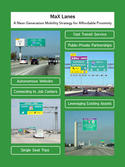The Budapest area has lost population overall since 1980, having fallen from 3.03 million to 2.99 million in 2016, according to Hungarian Central Statistical Office data as reported by citypopulation.de (Graphic 1). This 1.3 percent loss is smaller than the national population loss over the same period of 8.2 percent. Moreover, during the last five years, the Budapest area is estimated to have gained 1.7 percent, even as Hungary lost 1.1 percent. read more »
Planning
MaX Lanes: A Next Generation Strategy for Affordable Proximity
This is the introduction to a new report written by Tory Gattis of the Center for Opportunity Urbanism. Download the full report here.
The core urban challenge of our time is ‘affordable proximity’: how can ever larger numbers of people live and interact economically with each other while keeping the cost of living – especially housing – affordable? In decentralized, post-WW2 Sunbelt cities built around the car, commuter rail solutions don’t work and an alternative is needed, especially as we see autonomous vehicles on the horizon. read more »
- Login to post comments
Déjà Vu and the Dilemma for Planners
Some planners may be feeling a little angst. A few months ago, the Federal Highway Administration released 2016 vehicle miles of travel data, indicating robust travel demand growth in 2016, up 2.8%. The increase pushed total vehicle miles of travel (VMT) to a new record and boosted travel per capita to levels not seen since mid-2008. read more »
- Login to post comments
The Springfield Strategy
I just enjoyed an adventure in Springfield, Massachusetts with Steve Shultis and his wife Liz of Rational Urbanism. Steve does a far better job of describing his town and his philosophy than I ever could, but my interpretation can be summed up with an analogy about an old college room mate. read more »
- Login to post comments
America the Cheap
America is a price dominant culture, and we need to take responsibility for that when we complain about bad customer service, poor infrastructure, etc. Certainly American business and political leadership could be better, but they aren’t the ones who decided to shop at Wal-Mart instead of the local store (favoring short term financial gain over long term community loss). Nor are they the ones who force us to vote for politicians promising something for nothing. read more »
- Login to post comments
The Ghost of Mamie Eisenhower
There’s a certain amount of nostalgia these days for 1950’s suburbs when men were men and ladies mopped linoleum floors in white pumps and pearls. I’m not entirely sure that world ever really existed precisely the way it was portrayed on black and white television, but we seem to want it to be true. read more »
The Sad State of the University Degree for Planners & Designers
For the past four decades, technology has improved nearly all aspects of our life - except for the physical land development patterns of our cities. The 1960's suburban pattern, still in use today, is unsustainable. However, the 'architectural' answer to the 'planning' problem of sprawling subdivisions has been to simply go backwards to the gridded past. read more »
California: The Republic of Climate
To some progressives, California’s huge endorsement for the losing side for president reflects our state’s moral superiority. Some even embrace the notion that California should secede so that we don’t have to associate with the “deplorables” who tilted less enlightened places to President-elect Donald Trump. One can imagine our political leaders even inviting President Barack Obama, who reportedly now plans to move to our state, to serve as the California Republic’s first chief executive. read more »
- Login to post comments
Big Box Jesus
One of my cousins recently attended an event at a suburban church and I tagged along. I’m amoral and omnivorous. I’ll go to any house of worship on the odd chance I might actually learn something useful – and I often do. And I meet a lot of really nice people along the way. But mostly I like to explore the landscapes other people inhabit. Church provides an intimate glimpse into what people are thinking and feeling in a particular location. read more »
Canada’s Urban Areas: Descent from Affordability
Canada is a nation of wide open spaces, yet it has high urban area densities recently driven higher by a redefinition of urban area criteria (Note 1). Canada's largest urban area (population centre) is Toronto, with a population of 5.4 million continues to be the densest of the 59 with more than 50,000 residents. Toronto has a population of 3,028 per square kilometer (7,843 per square mile), approximately five percent above the European Union average. read more »
- Login to post comments




















